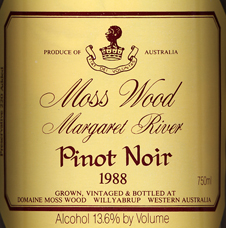Moss Wood 1988 Pinot Noir
Wine Facts
| Harvested: | 9/2/1988 |
| Bottled: | 23/3/1990 |
| Released: | 14/10/1990 |
| Yield: | 6.00 t/ha |
| Baume: | 13.10 |
| Alcohol: | 14.00% |
| Vintage Rating: | 8/10 |
SOLD OUT
Tasting Notes
The 1988 Moss Wood Pinot Noir has a medium ruby colour and shows a lovely freshness of fruit on the nose with Keith seeing hints of cherries, plums, beetroot and cinnamon. It has good acid, a depth of spicy, rich, berry fruit and strong, fine-grained tannins. The wine is fresh, supple, well-balanced, full of flavour and has considerable length. Although approachable now, the wine needs three to five years to reach its peak. It can be cellared with confidence for ten to fifteen years.[hr]
Vintage Notes
The winter of 1987 produced consistently mild weather with good spring rains which kept sufficient moisture on the vines to ensure good growing conditions. January 15, 1988 saw Moss Wood hit by its worst-ever hail storm. No substantial damage was done.
A warm spell during the last third of the season, fortunately not as hot as a similar spell in 1985, resulted in no stress for the vines and left them in good condition. Keith commented that the leaves looked good and the composition of the grapes on the vines allowed them to ripen without difficulty.
There has been an enormous flowering of the yellow and white blossoms of Marri gums which distracted the Silver Eye and, consequently, the grapes have suffered no damage from birds this year.
At harvest, acidity had reached high levels, fruit was in excellent condition and prospects for a good vintage were encouraging. The quantities are slightly down on 1987 but that was a bumper crop.
The Pinot is similar to, but better than, the 1984, 1985, 1986 and 1987. The colour is great, the fruit excellent and it has produced the best smelling fermentation ever. Keith expects the wine to have a big structure and to be high in tannins.
Production Notes
The 1988 Moss Wood Pinot Noir marks a minor change in the way the wine is produced, in an attempt to obtain fresher fruit characters. The fruit aromas and flavours that a wine exhibits are a product of the ripeness at which the grapes are picked. Accordingly, Pinot Noir picked at around 12°Beaume will display fresh cherry aromas and delicate berry characters. The same variety will exhibit ripe plum and herbal characters at 13°Beaume. Grape ripeness will, of course, affect another important wine quality factor - alcohol. This contributes to fullness of body and richness on the palate.
In Europe, where grape ripeness can be legally supplemented by the addition of cane sugar to the juice (a process called chapitalisation), it is possible to vary the alcohol content of a wine, without changing the ripeness at which the grapes are picked. The relevance of this in the production of Pinot Noir is that when wines are produced in Burgundy they may have a final level of alcohol of say 13.5% by volume, but may have had an original sugar level in the juice equivalent to 12.5% by volume and sometimes even less. In other words, the wine will display the fresh fruit perfumes of early picking and yet retain full body and richness on the palate.
In Australia, because chapitalisation is not possible, a wine with 13.5% by volume alcohol will display the ripe fruit characters of plums and herbs. This has been a very favoured approach and the wines have tremendous power and generosity but may lack some of the delicate perfumes.
As a result, the decision was taken to pick the 1988 Pinot Noir in 2 stages - some early, to obtain freshness and then some later to provide richness and weight, but still going for a final alcohol of not less than 13% by volume. Both batches are made using exactly the same techniques and then they are blended together at completion of fermentation. Amusingly, this technique has been used in production of Cabernet Sauvignon and Semillon at Moss Wood for at least a decade, but it seemed to take much longer to recognise its value for Pinot Noir.
The addition of whole bunches to the crush has been traditional at Moss Wood and this year made up 55% of both early and late picked parcels. The must was given twelve days skin contact. As usual, the fermentation technique involved keeping the juice at 35°C, with hand plunging up to six times a day and pigeage - plunging by foot. This latter technique involves using people in the tank breaking the cap formed by the skins over the top of the fermenting must. Plunging with the feet mixes these skins. The vivid image of pigeage which remains with Keith is of "Tinker" Bell waist deep in the open vat where normal mortals would be neck high in fermenting juice.
The 1988 Pinot Noir received twelve months in cask with 15% being aged in new French oak. In retrospect, Keith believes that the wine has developed the substance and depth of fruit to benefit from a slightly higher percentage of new oak.
Cellaring Notes
It can be cellared with confidence for ten to fifteen years.


